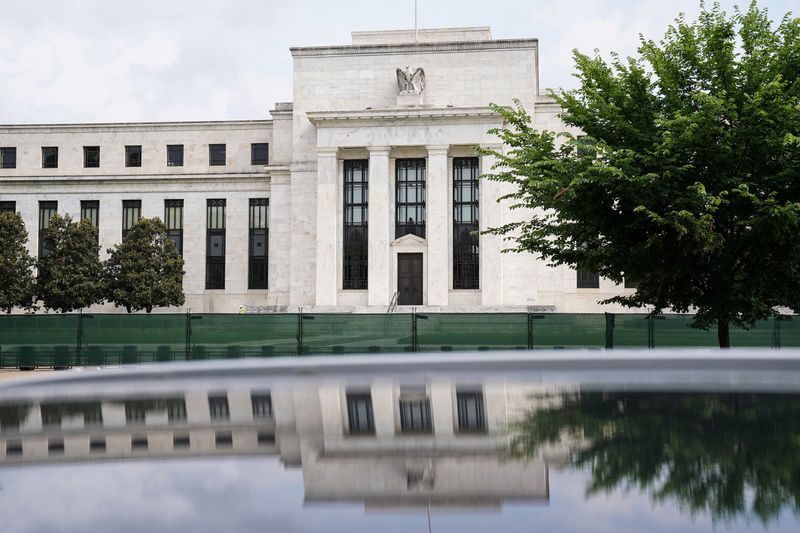(Bloomberg) -- Evidence that Federal Reserve policymakers recently discussed potential interventions in markets after any default by the US Treasury is reviving analysis of the central bank’s menu of options to shore up the financial system.
While Fed officials have sought to distance themselves from the partisan standoff over raising the debt limit, “they can’t be fully insulated because they have a duty to protect the economy and market function, as well as being Treasury’s fiscal agent,” LH Meyer/Monetary Policy Analytics economists wrote in a note this week.
The widespread assumption on Wall Street is that, if the Treasury Department runs out of sufficient cash to keep paying all federal obligations, it will ensure that interest and principal on Treasury securities — seen as the bedrock of the global financial system — are paid.
But Treasury Secretary Janet Yellen hasn’t given specific guidance for what happens if her department crosses X-date, when it runs out of sufficient cash. So that leaves a worst-case scenario of default as a potential tail risk, even if remote. She’s said the money to pay the nation’s bills could run out as soon as June 1.
Transcripts of Fed policymaker discussions in 2011 and 2013 debt-limit showdowns revealed that the central bank came up with a number of possible moves to prevent a full-blown financial crisis. Analysts have penciled in — or ruled out — others. The following is a look at the possible selection:
End/Pause QT
The Fed could slow or stop the current runoff in its bond portfolio, known as quantitative tightening. The current pace is up to $60 billion of Treasuries and $35 billion of mortgage-backed securities a month.
If markets are in “disarray,” then policymakers may not want to be removing liquidity from the banking system, Roberto Perli and Benson Durham wrote in Piper Sandler & Co. note earlier this year. Perli has since become the head of the New York Fed’s markets desk, where he’d help oversee any Fed market interventions.
The Fed could even decide to temporarily launch asset purchases — involving “non-defaulted” Treasuries — to support markets, as it did during the pandemic, Perli and Durham wrote.
Repo Facility
In the case of a technical default on Treasuries, that could roil the repo market, a key part of US financial plumbing. If rates surged in that market — and they have already ticked higher in some areas this week — the Fed could inject cash against the collateral of non-defaulted Treasuries, along with other assets.
The Fed already has a Standing Repo Facility, which could be “easily and quickly increased to any amount needed,” Perli and Dunham wrote. Officials could also consider expanding the universe of counterparties able to tap the program.
Reverse Repo
If turmoil caused such massive demand for high-quality short-term securities that interest rates fell too low, the Fed could temporarily enlarge its reverse repurchase facility, offering the likes of money market funds a place to park even more cash. There’s already more than $2 trillion being parked there daily.
In an extreme case, both repo and reverse repo operations could be in effect, Perli and Durham wrote.
Bank Lending
The Fed’s discount window gives it power to lend money to banks, against collateral. Banks turned to the discount window during the height of the pandemic and could tap the program again in the event there were disruptions to the banking system.
“There was consensus among officials” during the 2011 and 2013 discussions that “the Fed would continue to accept defaulted Treasury securities as collateral” for discount-window lending, along with repos, Anna Wong, chief US economist for Bloomberg Economics, wrote this week in a summary of what the Fed might do.
US INSIGHT: What the Fed Will and Won’t Do If US Defaults
Defaulted Treasuries would be valued at market prices, which would mean haircuts. but officials “were concerned about becoming — or even being perceived as — a market maker for defaulted Treasuries,” Wong wrote. “There was discussion of establishing a cap on how much in defaulted Treasuries they could buy.”
Money Markets
If money market funds were seeing major outflows — as their investors shunned accounts that invested in Treasuries — that would pose a particular danger, because these funds are key buyers of short-term government securities.
The ultimate risk, as Fed Chair Jerome Powell flagged in 2013, when he was a regular board member, would be the Treasury failing to sell all its debt at an auction. That would leave it without enough cash to pay off maturing securities, a move seen as catastrophic.
Read More: US Default Scenarios Span From Localized Pain to Dimon’s ‘Panic’
Fed staff more than a decade ago offered the option of opening a liquidity facility for money-market mutual funds, or directly purchasing Treasury bills. “Many” policymakers preferred buying bills, to reduce moral-hazard issues with regard to bailouts for money-market funds.
‘Loathsome’ Options
The Fed could effectively cleanse the Treasuries market with outright purchases of defaulted Treasury securities, or by swapping non-defaulted ones in its own portfolio for defaulted ones held by the public.
Powell, as a governor in 2013, referred to this as “loathsome.” But, “in extremis, I wouldn’t rule it out,” he said.
No Overdraft
While many Americans can simply keep making charges on their debit card even if they don’t have enough cash in their bank account, that’s not going to be possible for the US Treasury, according to LH Meyer/Monetary Policy Analytics.
The team at that research group, led by former Fed Governor Laurence Meyer, cite Fed staff having once said “they would only accept an ‘incidental’ overdraft of the Treasury’s General Account.”
“They will not abide by an ‘affirmative’ decision to extend credit to the Treasury,” the group wrote, noting it wasn’t presented as an option to the Fed in 2013. Allowing an overdraft “could pierce Fed independence irrevocably.”
And one could only imagine the fees.
©2023 Bloomberg L.P.

